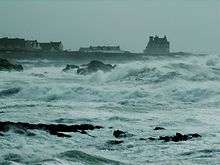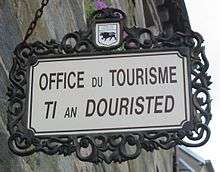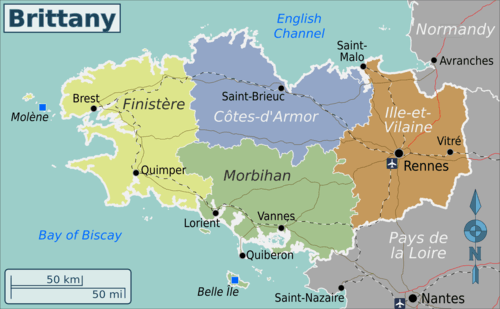Brittany
Departments
The region is subdivided into four administrative departments:
The department of Loire-Atlantique, which has been in Pays de la Loire since the 1950s, is historically and culturally related to Brittany, and the castle of Brittany's dukes is located in Nantes.
There are two different areas in Brittany, which are culturally different (language, habits, dances, food...):
- the Haute-Bretagne ("Breizh Uhel" in Breton), the eastern part (Ille-et-Vilaine, Loire-Atlantique, eastern Côtes-d'Armor and eastern Morbihan), where Gallo language is spoken.
- the Basse-Bretagne ("Breizh Izel" in Breton), the western part (Finistère, western Côtes-d'Armor, western Morbihan and the area around Guérande), where Breton language is spoken.
Cities

Other destinations
- 🌍 Carnac — the megalithic menhirs - stones erected by the prehistoric peoples of Brittany
- 🌍 Lac de Guerlédan — an artificial lake created by EDF, a scenic highlight of interior Brittany
- 🌍 Côte d’Émeraude — verdant rocky coast stretching from St Malo to St Brieuc - bustling resorts, charming fishing villages
- Pays de Montfort — a natural and hiking destination between Rennes and the forest of Brocéliande
- 🌍 Monts d'Arrée — a mountainous area in Finistère, with heathland.
Breton islands:
Understand
.svg.png)
Brittany received its modern name when it was settled (in around 500 AD) by Britons, whom the Anglo-Saxons had driven from Britain. Breton history is one long struggle for independence: first from the Franks (5th to 9th centuries), then the Counts of Anjou and the Dukes of Normandy (10th to 12th centuries), and finally from England and France.
The Breton people maintain a fierce sense of independence to this day, as displayed by their local customs and traditions.
Since the 1970s, a resurgence of the regional identity has happened in Brittany. Breton art, music and culture are recognized across France.
Talk

Being a part of France, French is universally spoken and understood by almost all locals in Brittany.
In the western part of Brittany (Basse-Bretagne), many people also speak the regional Breton language, a Celtic language more closely related to Welsh, Cornish and Irish than to French. While France tried to discourage the use of regional languages, their use is rebounding, bringing a stronger understanding of culture, contributions, and history. Through the local efforts of the Bretons and their Breton language schools (Diwan, Div Yezh, Dihun), children are being taught in the native language while they learn standard curriculum. The schools are supported by worldwide efforts through various groups, including the International Committee for the Defense of the Breton Language.
On the road you may notice signs in both French and Breton.
On the eastern Brittany, the Gallo language is sometimes spoken. That's a French variant language, influenced by Breton.
Due to its proximity to the UK, many people working in the tourism industry can also speak English. Some English people also live in Brittany, especially in the countryside.
Get in
By ferry
- Channel Islands.
- Jersey and Guernsey to Saint-Malo
- Ireland.
- United Kingdom
- Plymouth to Roscoff and Portsmouth to Saint-Malo
Brittany Ferries operates the following regular services:
- Plymouth-Roscoff (Pont-L'Abbé, Pont-Aven, certain winter sailings operated by Bretagne)
- Poole-Cherbourg (Barfleur, Coutances, Normandie Vitesse (BF trading name for Condor Vitesse)
- Portsmouth-St Malo (Bretagne with winter service operated by Pont-Aven)
- Portsmouth-Ouistreham (Caen) (Mont St Michel, Normandie, Normandie Express, refit cover provided by Bretagne)
- Roscoff-Cork (Pont-Aven, occasionally Bretagne)
By plane
There are airports in Brittany:
- 🌍 Brest Bretagne Airport (BES IATA). Ryanair flight from Luton and Dublin, Flybe from Birmingham, Exeter, Manchester Airport, Southampton, from Paris and some other French towns, mainly with Hop! - Air France)
- 🌍 Dinard–Pleurtuit–Saint-Malo Airport (DNR IATA). Ryanair flight from Stansted, and Luton in summer
- 🌍 Lannion – Côte de Granit Airport (LAI IATA). Airlinair flight from Paris Orly (ORY IATA)
- 🌍 Lorient South Brittany Airport (LRT IATA).
- 🌍 Quimper–Cornouaille Airport (UIP IATA).
- 🌍 Rennes–Saint-Jacques Airport (RNS IATA). flights from Paris and some other French towns, mainly with Hop! - Air France
- 🌍 Saint-Brieuc – Armor Airport (SBK IATA). Channel island flights
The Nantes Atlantique Airport (NTE IATA) may also be used along the southern coast or Rennes to/from other European airports and for some transatlantic flights.
By train
The TGV train runs almost hourly from Paris Montparnasse to Rennes, and then Brest, Quimper, Lannion and Saint-Malo. SNCF website
Regional trains also link Rennes to Nantes (via Redon) and Saint-Malo; Quimper to Brest.
By car
The A11, the Océane Route, links Brittany to Paris. A dual carriageway runs from Rennes to Nantes, and there is a motorway from Nantes to Bordeaux and from Rennes to Normandy (A84)
By bus
Bus companies offer bus services from and to all major rail stations in Brittany.
Get around
In Brittany, all roads are free (no tolls).
Trains are an easy way to visit Brittany, except for the center of the peninsula. There is no difference between TGV high-speed train and regional trains (TER) in Brittany: both run at the same speed, and regional trains are usually cheaper and as comfortable as TGVs.
See
- Menhirs and Dolmens Brittany has a large number of megaliths, which simply means "big rocks". These menhirs (standing stones) and dolmens (stone tables) were sites for burials and worship. See some magnificent examples at the bay of Morlaix and the gulf of Morbihan. Museums at Vannes and Carnac detail the archaeological finds made at these sites.
- Gardens Brittany has exceptionally beautiful gardens. See https://en.wikipedia.org/wiki/Remarkable_Gardens_of_France
Do
- Participate in a fest-noz. Fest-noz (Breton for "night fest") are dancing sessions open to everyone, where people learn to dance traditional dances from Brittany, usually from 6PM to 2AM. It will cost you from nothing to €8 to participate in a fest-noz (most of them have a €6 fee). More globally, Breton people tend to dance when they hear traditional music so you may see people dancing in the street.
- Music festivals. There are plenty of festivals in Brittany, some of which are huge and have an international audience:
- Les Vieilles Charrues (in July in Carhaix) one of the biggest European festivals
- Festival interceltique de Lorient (first week of August in Lorient), one of the biggest festivals in the world dedicated to Celtic music, with participants from all of the Celtic nations.
Eat
- Kig ha farz — meat and stuffing
- Coquilles Saint-Jacques — famous in Saint-Brieuc
- Oysters — famous in Cancale
- Crêpes and galettes are among the regional specialties, that you can eat on the numerous crêperies you can find in quite every places.
- crêpes are made from buckwheat flour (traditionally but rarely in crêperies) or wheat flour, they are eaten on Basse-Bretagne
- galettes are traditionally eaten in Haute-Bretagne, and are only made of buckwheat flour
- Galette-saucisse — a grilled sausage rolled onto a fresh galette, traditional snack in Ille-et-Vilaine, you can buy some in markets or at sportive events
- "Galette complète" — a galette filled with ham, cheese and an egg.
- Tourteaux (large crabs) and spider crabs
- Far breton — cake made with prunes and eggs
- Kouign amann — butter cake, served lukewarm
- Galette — butter sweet biscuit from Basse-Bretagne, not the same as galette from Haute-Bretagne
Drink
- Cider (cidre) — Like Normandy, Brittany is cider country. Much like wine, cider comes in different varieties that are intended for different purposes, so you should pay attention to the following words on the label. Doux indicates a sweet cider, with a strong apple flavour and low alcohol percentage (3% or below), that is best drunk with dessert or by itself. Demi-sec / brut is sharper and fresher, with an alcohol content of between three and five percent. This kind of cider is more common as an apéritif, or as an accompaniment to local cuisine, especially seafood. Unlike in certain other countries, notably the United States, cider in Brittany is always alcoholic and always sparkling (pétillant).
- Perry (poiré) — Similar to cider, but made from pears. Production is considerably limited compared to its apple-based counterpart.
- Chouchen — Breton mead, a sweet alcohol made from fermented honey, water and yeast
- Beer — there is a great variety (some of them are made with sea water)
- Whisky — There are Breton whiskies. Nevertheless, there are better ones in the Gaelic world...
- Kir Breton — the local adaptation of the kir. You pour Breton cider instead of white wine, preferably from the Rance valley. (Kir, for those uninitiated, is blackcurrant liqueur and white wine.)
Stay safe
When swimming in the sea, watch out for rips and undercurrents. Be mindful that the tide can come at a very fast pace so watch out or you might be stranded on an outlying island! Check the tides (marées) in your local tourist office. Ask for a table of the tides.
Go next
- Channel Islands
- Mont Saint Michel - in Normandy, but very close to the Brittany border; monastery and town built on a tiny outcrop of rock in the sand, which is cut off from the mainland at high tide (and then joined to the continent by a light bridge; cars and buses can no longer pass or park near the Mont, but there's a transport system with light buses). It is one of France's major tourist destinations, and as such gets very busy in high season. Check the times of the tides before you visit!
